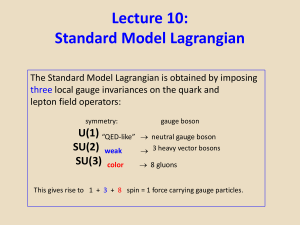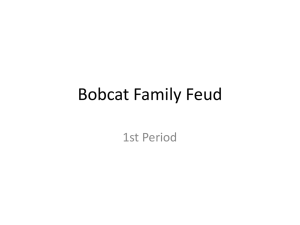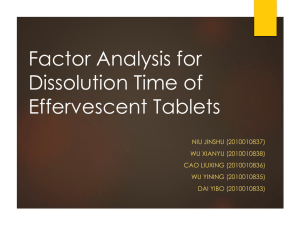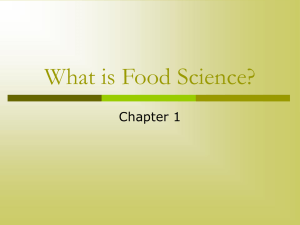ppt
advertisement
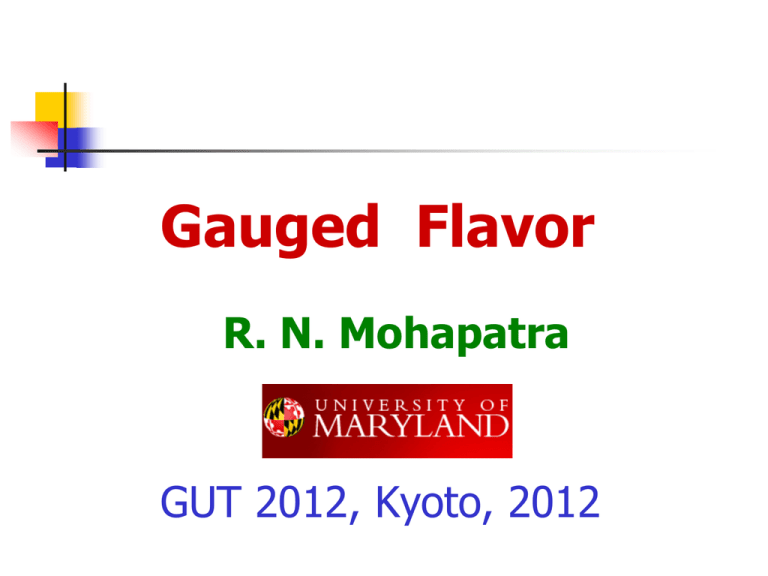
Gauged Flavor R. N. Mohapatra GUT 2012, Kyoto, 2012 Two Fundamental puzzles of SM (i) Origin of Mass: two problems: (a) quark masses : SM Higgs (b) neutrino masses; New Higgs, New symmetries (ii) Origin of Flavor: Fermion masses, mixings, CP and P, strong CP Understanding Flavor Zero fermion masses SM + RH nu flavor symmetry group: U (3) Q U (3) u U (3) d U (3) U (3) e U (3) N Hope is that observed flavor structure is a consequence of breaking this symmetryQuestions: a) Gauge or global symmetry ? b) Scale of the symmetry breaking? c) New dynamics of the symmetry ? Global Flavor symmetry Continuous:Breaking leads to massless familons (Wilczek) Must decouple before BBNNot seen in experiments so farLimits on the scale (PDG): 10 M H 10 GeV from e and K decays: (Jodidio et al. ; Atiya et al ) Discrete :Domain wall problem; not favored by string theories unless gauged (an argument in favor of gauged flavor) Gauged Flavor Symmetry SM provides an excellent description of flavor violation. Accident or something fundamental ? Minimal Flavor violation hypothesis: (Chivukula, Georgi; Buras et al; D’Ambrosio et al) -Any Flavor [U(3)]6 breaking effect is proportional to SM Yukawa type spurions: Yu ~(3, 3* , 1), etc. Example of a theory where this happens: SUSY with universal scalar masses or GMSB etc. Universal scalar masses Need for Flavor gauging A natural speculation: the spurions are vevs of actual scalar fields: If flavor symmetry is not gauge symmetry, there will be massless Goldstone bosons and are troublesome for cosmology. How to implement this in a proper way and does it have any observable effect ? Naïve Gauged Flavor and gauged flavor scale No extra fermionsAnomaly constraints restrict gaugeable symmetries to vector subgroups ; global anomaly freedom) (needs RH neutrino for Scale of symmetry breaking set by FCNC : 2 H F 2 gH M 2 H q i q j q i q j h .c . imply (for gH~1) (UTFIT coll. Bona et al) 1000 TeV K L K S , D D , BS BS M H Typical structure of these theories: Gauge group: G SM SU ( 3 ) H ,V Sym Br. Higgs: SM H + Yu , ij (Y-flavon fields) < Yu , ij> breaks flavor sym; H breaks SM; Y u ij, ij Fermion masses arise from (typically) Q i Hu j Implies e.g. that: Y u , 33 Y u , 22 Y u ,11 H F 2 ~ .M H g M 2 H 2 H Y u , ij q i , L q j , L q i , L q j , L L R .. New approach: Use Quark seesaw: Add vector like quarks to SM ( seesaw like mass matrices: M q 0 m q R m q L M u ,d ) and use m m q R mM q L m ~ u , d M MQQ 1 In Left-Right models M u , ij v wk v R u , i M , ij u , j # of parameters: for quarks only 24 in LR; 48 in SM (Davidson, Wali’87;… Babu and RNM’89,…..) Full Flavor Gauging Advantage of seesaw approach in SM: Full chiral flavor group can be anomaly free and can be gauged (Grinstein, Redi and Villadoro’09) Quark masses: 1 M q ,ij v wk M q M ,ij 2 q Note inverted hierarchy for masses !! Flavor scale is same as vector like quark mass One flavor scale comes down to TeV range; New vector like quarks in the LHC range; Basic reason for lower scale Inverse relation between quark and vector like masses for Horizontal scale: Y u , 33 Y u , 22 Y u ,11 m 2 H F 2 gH M 2 H 1 t :m 1 c :m 1 u m u gH q i q j q i q j h .c .H F 2 2 22 q q j qi q j 2 2 i 2 M h .c . M V Hv wk Huge suppression Lower flavor gauge scale for higher flavors. A Conceptual problem Gauge protection of fermion masses : “all fermion masses must arise from a gauge symmetry breakingotherwise it could be of the order of Planck mass !!” e.g. in QED, electron mass is not gauge protected but in SM, it is. In GRV model, ( d R , ), ( u R , ) pairs have same gauge quantum numbers and get arbitrary gauge unprotected mass. No neutrino mass d L u L Flavor gauging with LeftRight Symmetry Guadagnoli, Mohapatra , Sung, arXiv: 1103.4170 JHEP 04, 093 (2011) LR allows more economical flavor gauging: U (3) U (3) U (3) U (3) U (3) U (3) From (SM) U (3) Q , L U (3) Q , R U (3) , L U (3) , R to (LR) Q u d e N All Fermion masses gauge protected-connected to weak, LR and flavor gauging scales !! (i) generates neutrino mass (ii) Solves strong CP problem from parity (iii) # of parameters: 10 for quarks: connected to symmetries Two versions: TeV parity or no parity TeV SU(2)R Details of Model Anomaly free Fermion and Higgs assignment: Some details: TeV parity Quark sector: Fermions: Q L , R V , L , R ; Vectorlike quarks Higgs fields: LR doublets: L , R Flavon fields: Y u , d ( 3 , 3 ) (EW singlets) Yukawa couplings and fermion mass protection: LY= Flavor from sym br. Yd Y d Ys Y b ; Y u V CKM Yu Yc V CKM Y t Consequences: Seesaw matrix: 0 u v R u v L similarly for d Yu All flavor consequence of symmetry breaking; Two new scales beyond SM Right hand weak scale: vR , Flavor scales <Y>; Quark seesaw Y Y Y u c t Ymixings. Yt Flavor gauge boson masses determined by Yu quark c 2 æ mu g 2ö FCNC interactions given by~ ç H F 2 H2÷ q i q j q i q j h .c . vR Hø è lu vwkM KL –KS imply Yu > 2000 TeV; top partner ψ ~200 GeV for v ~ TeV. FCNC Bounds on new physics: Flavor gauge boson and vectorlike quark masses TeV parity(orange): MVH>10 TeV; M > 5 TeV; otherwise (blue) much lower-both near a TeV. Special top sector Predicts large top mixings with vector like quarks due lower Yt large FCNC (in progress) RH top LH top LHC searches for vectorlike quarks Production: ATLAS 1.04fb-1 : 3rd gen. partner MQ > 760 GeV. For TeV mass ~ 10 fb CMS: pp->QQ-bart+Z+t-bar+Z MQ > 475 GeV Other consequences Reduction of top width t cg probe Parameterize: L eff t R SM prediction ~ 10 5 c L G (TeV ) 1 5 D0: ~<.018 10 (TeV ) Our model: intermediate top partner mediated graph 3 1 3 TeV 5 10 ~ 10 (TeV ) Y u , 33 1 FCNC and other effects of Gauged Flavor Possible anomaly can be resolved by new contributions; and predictions are SM – like. (Buras, Carlucci, Merlo, Stamou’2011) Full anomaly free gauge group can be extended to have chiral color; The model has axigluon, sometimes invoked to explain the 3-σ tt-bar asymmetry of CDF and D0 for Maxi ~ 500 GeV or so. Other Consequences Non-unitarity of CKM matrix (Branco, Lavoura’86; Branco, Morozumi, Parada, Rebelo’94) V CKM (1 1 )U T L 2 vL M ui Effects small; < 1-2 % Collider constraints and prospects: LHC pp X , t t t H bWb b Striking LHC signal 6b+2W Origin of flavor hierarchies :<YU,D> encode the flavor pattern. How to understand this ? Step I: Higgs potential V VU V D VUD U U U U VU M TrY YU 1 (TrY YU ) 2 Tr (Y YU Y YU ) 2 U 2 For 2 0 , minimum of VU is <Yu>= (a1, 0, 0); induces <Yd >=(b1,0,0) with b1 ~ a1 Generates largest flavon vevs; smallest quark masses Sym breaks : More flavor structure Add new term to V: Generates hierarchical masses: Add Det Yu induces <Yu1 1 > ≠ 0; induces <Yd > Next order and mixings More terms in the potential: can generate the full mixing matrix e.g. (Admittedly there is fine tuning !!) A Numerical analysis Minimum of the potential: Loop alternative Add new interaction of vectorlike quarks: sextet L I u u L+R L RY ' [Y’= ] <Y’>≠ 0 Generates hierarchical fermion masses and mixings Similarity to MFV hypothesis All flavor structure resides in the scalar multiplets of GH :Yu,d . All higher order flavor stucture therefore necessarily comes from them, as in MFV hypothesis. Solution to strong CP problem: Seesaw Quark mass matrix: M q 0 v I q R qvL I Y q Arg Det M = 0 at tree level. tree 0 One loop also maintain zero theta. New contribution at 2 loop. No axion needed. Planck scale corrections small for TeV scale parity unlike the axion solution. ( Babu, RNM’89) Estimating θ 2-loop (Babu, RNM’89) e.g. Lepton sector Lepton sector similar Neutrinos Dirac in the minimal model: For eSM , correct nu masses emerge- much less tuning than SM. Predicts Dirac nu as it is ! For Dirac nu, WR bound goes up to 3.3 TeV from BBN. LFV imply <Yν> ~103 TeV Suspected symmetries could be subgroups of GH Implications for B-violation Forbids D=6 proton decay operator; Lowest allowed operator: QQψdRψdRQQ ΔB=2 N-N-bar oscillation Also allows sphaleron operator: QQQQQQQQQLLL If SU(3)Q =SU(3)l , allowed operator Observation of p-decay can rule out model. Gauged Flavor with SUSY Need for maintaining susy and sym breaking. First problem D-terms can split squark masses enough to cause FCNC problems i.e. However in GMSB framework, our Y does not get susy breaking mass till 3 loop; OK. Change of Higgs mass bound D-term causes increase in Mh over MSSM: +rad. corr. (An, Ji, RNM,Zhang’08) R-parity violation and pdecay problem If model supersymmetrized, allows only R-P breaking terms of type: ψuc ψdcψdc After sym breaking uR dRdR Leads to neutron-anti-neutron oscillation: Very similar to MFV models (Smith’09; Grossman et al’11) Usual SUSY GUTs: Planck induced QQQL/MPl needs 107 suppression: No such problem in gauged F-models Possible Grand unification: SU(5)xSU(5) model (in progress) Where do vector-like fermions come from? Grand unification provides a justification: SU(5)xSU(5)x GH as an example dc 1 c2 d c3 d e L 0 u ,3 u ,2 u1 0 u ,1 c u2 0 u3 c c 0 d1 d2 d3 c e 0 + L R L anomaly free G H U ( 3) U ( 3)10 U ( 3) 5 U ( 3) N ; non-chiral Examples: SU(3)H , SO(3)H Some Implications of unifying seesaw Seesaw matrix from Lagrangian: SU(3) case L ( h d T F H Y d , 6 hu TTHY ) / M P d F L 5 , 5 F R u T L 10 ,1 0 T R u ,6 u different from previous case. (Koide’s talk) Coupling unification possible and chiral color surviving down to TeV, with extra pair of left and right Higgs doublet. MU = 2.3x1013 GeV Sin2 θW = Need to have different couplings for the two SU(5)’s at GUT scale !! Proton decay can explore light heavy mixings No electroweak sym breaking proton is stable !! . Operator generated by GUT gauge boson exchange OB = /MU 2 ; Coupling unification different from usual MU =1013 GeV EWSB mixes heavy vector like quarks with light . quarks p-decay Operator: If vR /Mψ =10-3 , proton life time constraint ok. (For an alternative GUT approach: Feldmann (2011)) Conclusion New approach to gauged flavor: FCNC allows flavor scale in TeV range (unlike simple gauged case); Key to this: quark seesaw with new TeV mass vectorlike fermionsrealization of MFV LR version “protects all fermion masses”, solves strong CP problem and gives neutrino masses. Flavor mixings and hierarchies out of flavor breakingCan be supersymmetrized. Possibly grand unifiable (work in progress)!! Unbroken subgroups can be used to predict mixings ! LR scale INPUT for TeV parity case Low energy observables: combination of KL-KS, εK, d_n together.(uncertainty long distance effetcs); Parity defined as usual:( L R ) minimal model: M WR (An,Ji,Zhang,RNM ’07) 4 TeV Parity as C (as in SUSY i.e. c ) (Maezza, Nemesvek,Nemevsek,Senjanovic’10) M W R 2 . 5TeV A recent study by ( Buras, Blanke,Gemmler, Heidesiek’11) Collider (CDF,D0) 640-750 GeV; CMS- 1.7 TeV Muon decay (TWIST) 592 GeV Broken TeV parity: g L g R weaker bounds on MWR No large tree level Higgs effect unlike canonical LR models. Bounds on New Physics from FCNC Bounds on scale: Is the dynamics of flavor then experimentally inaccessible ?
